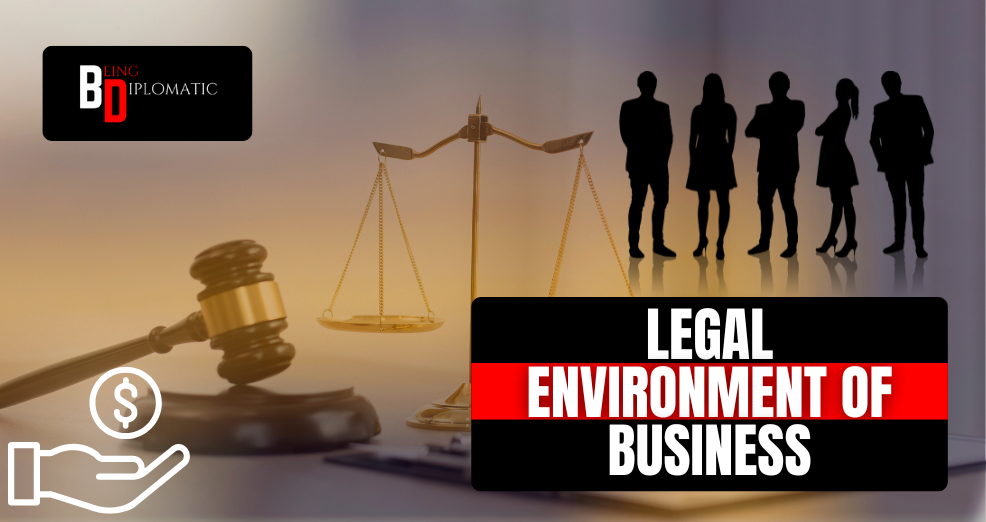Legal Environment of Business
The legal environment of business refers to the system of laws, regulations, and standards that govern business activities and transactions.
It provides the framework within which businesses operate, interact with stakeholders, and conduct their daily operations
This environment encloses comprehensive legal issues that businesses should ensure compliance, protect their interests, and mitigate risks.
Key Aspects of the Legal Environment of Business
- Business Formation and Structure
- Contracts
- Intellectual Property
- Employment Law
- Regulatory Compliance
- Consumer Protection
- International Business
- Dispute Resolution
- Conclusion
Business Formation and Structure
Sole Proprietorship: A sole proprietorship is the simplest form of business structure, where an individual owns and operates the business.
The business is owned and controlled by one person.
The owner has unlimited personal liability for the business’s debts and obligations, meaning personal assets are at risk.
Partnership: Where two or more individuals share ownership and responsibility for the business.
Explain the differences between general partnerships (where all partners have unlimited liability).
Corporation: Describe corporations as separate legal entities owned by shareholders, who enjoy limited liability for the company’s debts.
Discuss the process of incorporating a business, including filing articles of incorporation and issuing stock.
Contracts
A contract is a legally binding agreement between two or more parties that creates rights and obligations enforceable by law.
The basic elements to enforce a contract legally include offer, acceptance, consideration, validity, capacity, and intention to form legal relationships.
The process of contract formation, including negotiation, offer and acceptance, consideration, and the requirement of mutual assent.
Also Read: Amazon marketing strategy case study
Intellectual Property
Intellectual property refers to creativity, such as inventions, literary and artistic works, designs, symbols, names, and images used in commerce.
Types of Intellectual Property
- Patents: Protect inventions and discoveries.
- Copyrights: Protect original works of authorship, such as books, music, and artistic creations.
- Trademarks: Protect symbols, names, and slogans used to identify and distinguish goods and services in the marketplace.
- Trade Secrets: Protect confidential information that provides a competitive advantage, such as formulas, processes, and customer lists.
Intellectual property rights incentivize innovation and creativity by granting creators and innovators exclusive rights to their creations.
Discuss protecting intellectual property in a global economy, considering legal system differences, enforcement mechanisms, and cultural attitudes towards IP.
Employment Law
Employment law governs the legal relationship between employers and employees, covering a wide range of issues related to hiring, compensation, working conditions, and termination of employment.
Laws prohibit discrimination in the workplace based on protected characteristics such as race, color, religion, sex, national origin, age, disability, and genetic information.
Laws regulating minimum wage, overtime pay, and other aspects of compensation.
Discuss the Fair Labor Standards Act (FLSA) and its provisions regarding minimum wage, overtime pay, child labor, and exemptions for certain categories of employees.
Regulatory Compliance
Regulatory compliance refers to the process of ensuring that a business adheres to laws, regulations, guidelines, and standards relevant to its industry, operations, and geographical location.
Compliance requirements explain the specific requirements that businesses must fulfill to comply with regulations, such as obtaining licenses and permits, maintaining accurate records, conducting audits and assessments, and implementing internal controls and policies.
Regulatory agencies and authorities identify the government agencies, regulatory bodies, and authorities responsible for enforcing regulations in different jurisdictions.
International regulatory compliance addresses the challenges and complexities of achieving compliance with international regulations and standards, particularly for businesses operating across multiple jurisdictions.
Continuous improvement and adaptation emphasize the need for businesses to continuously monitor changes in regulations, assess their impact on operations, and adapt compliance strategies accordingly.
Consumer Protection
Consumer protection refers to laws, regulations, and initiatives designed to safeguard consumers from unfair or deceptive business practices, ensure product safety and quality, and promote fair competition in the marketplace.
The Consumer rights outline the fundamental rights that consumers are entitled to, including the right to safety, the right to be informed, the right to choose, the right to be heard, and the right to redress.
Consumer protection laws identify key legislation and regulations aimed at protecting consumer rights and interests, such as:
- The Consumer Protection Act (CPA) or similar laws in different countries, prohibit unfair and deceptive practices in advertising, marketing, and sales.
- Product safety regulations set standards for consumer products’ safety and quality and require manufacturers to label products with appropriate warnings and instructions.
- Truth-in-advertising laws, mandate that businesses provide accurate and transparent information about their products and services to consumers.
- Consumer finance regulations, govern practices related to lending, credit reporting, debt collection, and other financial services to protect consumers from predatory practices and financial abuse.
- Data protection and privacy laws regulate the collection, use, and disclosure of consumers’ personal and sensitive information to prevent privacy breaches and identity theft.
Complaints of consumers and redress discuss mechanisms available to consumers for lodging complaints, seeking redress, and resolving disputes with businesses, such as consumer protection agencies, ombudsman services, and alternative dispute resolution (ADR) methods like mediation and arbitration.
Also Read: What is print marketing? All you need to know in 2024
International Business
International business refers to commercial activities conducted between businesses or individuals in different countries, involving the exchange of goods, services, capital, technology, and knowledge across international borders.
Globalization and international trade discuss the role of globalization in driving the growth of international business, facilitating trade liberalization, economic integration, and the expansion of multinational corporations (MNCs) into global markets.
Different modes of engaging international business, including:
- Exporting and importing: Selling goods and services to foreign markets or purchasing goods and services from overseas suppliers.
- Foreign direct investment (FDI): Establishing subsidiaries, branches, or joint ventures in foreign countries to engage in production, sales, or investment activities.
- Licensing and franchising: Granting rights to use intellectual property, trademarks, or business models to foreign partners in exchange for royalties or fees.
- Contract manufacturing and outsourcing: Outsourcing production, services, or business processes to third-party suppliers or contractors in other countries.
International market entry strategies discuss strategies for entering and expanding into international markets, such as:
- Market research and analysis: Conduct market research to identify opportunities, assess market demand, analyze competition, and evaluate cultural and regulatory factors.
- Market segmentation and targeting: Segmenting global markets based on demographics, preferences, and behavior and targeting specific market segments with tailored products, services, and marketing strategies.
- Strategic alliances and partnerships: Forming strategic alliances, joint ventures, or partnerships with local companies or stakeholders to leverage local knowledge, resources, and distribution channels.
- Mergers and acquisitions (M&A): Acquiring or merging with existing businesses in foreign markets to gain access to established brands, customer bases, or distribution networks.
International business environment. discuss factors that influence international business operations and decisions, including:
- Political and legal factors: Political stability, government policies, trade regulations, taxation, intellectual property protection, and legal systems.
- Economic factors: Economic conditions, exchange rates, inflation, interest rates, and market trends
- Socio-cultural factors: Cultural values, beliefs, norms, languages, consumer behavior, and preferences.
- Technological factors: Technological advancements, digitalization, e-commerce, and innovations in communication and transportation.
Dispute Resolution
Dispute resolution encompasses various mechanisms and techniques for resolving conflicts, disputes, or disagreements between parties peacefully and efficiently, without resorting to litigation.
There are several methods of dispute resolution, including:
- Negotiation: Direct communication between parties to reach a mutually acceptable solution without the involvement of a third party.
- Mediation: A neutral third party (the mediator) facilitates communication and negotiation between the parties to help them reach a voluntary settlement.
- Arbitration: A neutral third party (the arbitrator) hears arguments and evidence from both sides and decides to resolve the dispute.
- Litigation: Resolving disputes through formal legal proceedings in a court of law, where a judge or jury decides the outcome based on evidence and legal arguments presented by the parties
Advantages of alternative dispute resolution (ADR)discuss the advantages of using ADR methods over traditional litigation, including:
- Cost-effectiveness: ADR processes are often faster and less expensive than litigation, saving parties time and money.
- Flexibility and informality: ADR allows to customize the process to suit their needs and preferences, maintaining confidentiality and relationships.
- Control and autonomy: Parties have more control over the outcome and can participate in the resolution process, leading to greater satisfaction.
- Preserving relationships: ADR methods focus on collaboration and cooperation, allowing parties to maintain relationships and avoid the adversarial nature of litigation.
The legal framework for dispute resolution explains the governing dispute resolution, including laws, regulations, and court rules that govern the use of ADR methods, enforce arbitration agreements, and ensure the enforceability of arbitral awards.
The role of dispute resolution professionals discusses the role of mediators, arbitrators, and other dispute resolution professionals in facilitating the resolution process, maintaining neutrality, and ensuring procedural fairness.
Also Read: 10 truths about marketing after the pandemic
Conclusion for Legal Environment of Business
In conclusion, understanding the legal environment of business is essential for entrepreneurs, business owners, and managers to navigate the complexities of the modern marketplace.
From business formation and structure to regulatory compliance, intellectual property protection, employment law, consumer protection, international business, and dispute resolution, companies must adhere to legal requirements, mitigate risks, and uphold ethical standards to succeed in today’s competitive landscape.
By proactively managing legal risks, complying with applicable laws and regulations, and fostering a culture of ethics and compliance, businesses can build trust with stakeholders, protect their reputations, and sustain long-term success.



